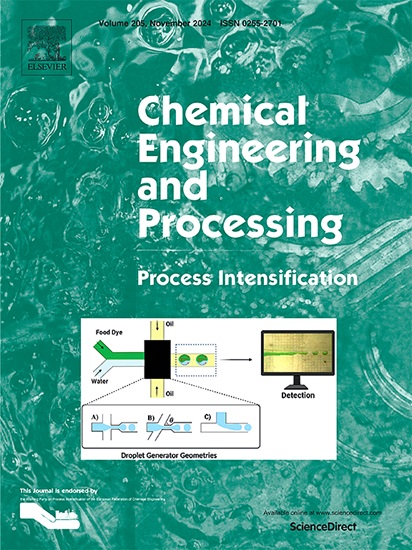Process modeling, simulation and thermodynamic analysis of a novel process integrating coal gasification, smelting reduction and methanol synthesis for ironmaking and methanol co-production
IF 3.8
3区 工程技术
Q3 ENERGY & FUELS
Chemical Engineering and Processing - Process Intensification
Pub Date : 2025-02-14
DOI:10.1016/j.cep.2025.110231
引用次数: 0
Abstract
A novel process integrating coal gasification, smelting reduction, and methanol synthesis process has been proposed and designed to produce both high-quality hot metal and methanol. This process comprises eight key units: Coal Gasification Pre-reduction, Smelting Reduction, Water Gas Shift, Acid Gas Removal, CO2 Compression and Storage, Gas and Steam Turbine, Methanol Synthesis, and Distillation. The innovative aspect of this process lies in the partial recycling of H2 rich clean syngas which is generated from the WGS and AGR stages. Key operational parameters based on the feed of coal is 100 tones/h, such as the ore/coal ratio, oxygen/coal ratio, circulation ratio (CR), and oxygen replenishment (OR) were optimized at values of 1.4, 0.8, 0.5, and 10 tons/h, respectively, enabling the co-production of 100 tons of hot metal and 55 tons of methanol. Thermodynamic analysis indicates that the energy consumption, energy efficiency, and exergy efficiency of the CGSRMS system per unit of product (1 t-Fe and 0.55 t-CH3OH) are 10.47 GJ, 73.06 %, and 72.12 %, respectively. CO2 emissions are significantly reduced to 0.91 t/h per unit of product, representing a 51.81 % decrease compared to conventional processes with same production outputs.

炼铁和甲醇联产煤气化、冶炼还原和甲醇合成新工艺的过程建模、仿真和热力学分析
提出并设计了一种集煤气化、冶炼还原和甲醇合成工艺于一体的新型工艺,可同时生产高质量的铁水和甲醇。该工艺包括八个关键单元:煤气化预还原、熔炼还原、水煤气转换、酸性气体去除、二氧化碳压缩和储存、燃气和汽轮机、甲醇合成和蒸馏。该工艺的创新之处在于部分回收WGS和AGR阶段产生的富含H2的清洁合成气。在煤进料为100吨/h的条件下,将矿煤比、氧煤比、循环比(CR)、补氧比(OR)分别优化为1.4、0.8、0.5、10吨/h,实现了100吨铁水和55吨甲醇的联产。热力学分析表明,CGSRMS系统每单位产品(1 t-Fe和0.55 t-CH3OH)的能耗、能效和㶲效率分别为10.47 GJ、73.06%和72.12%。每单位产品的二氧化碳排放量显著降低至0.91吨/小时,与产量相同的传统工艺相比,减少了51.81%。
本文章由计算机程序翻译,如有差异,请以英文原文为准。
求助全文
约1分钟内获得全文
求助全文
来源期刊
CiteScore
7.80
自引率
9.30%
发文量
408
审稿时长
49 days
期刊介绍:
Chemical Engineering and Processing: Process Intensification is intended for practicing researchers in industry and academia, working in the field of Process Engineering and related to the subject of Process Intensification.Articles published in the Journal demonstrate how novel discoveries, developments and theories in the field of Process Engineering and in particular Process Intensification may be used for analysis and design of innovative equipment and processing methods with substantially improved sustainability, efficiency and environmental performance.

 求助内容:
求助内容: 应助结果提醒方式:
应助结果提醒方式:


